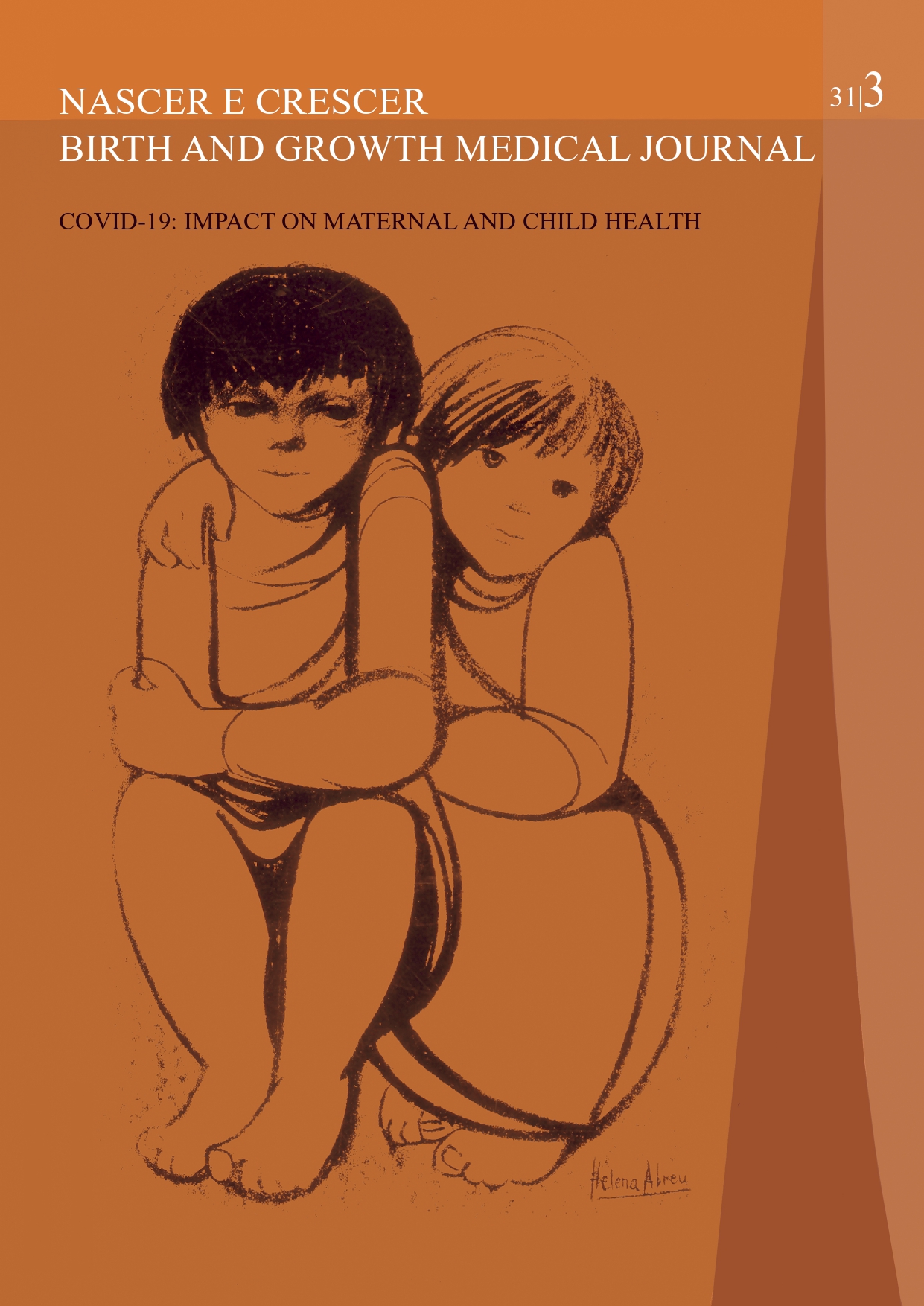Pediatric anorexia nervosa: the impact of the COVID-19 pandemic
DOI:
https://doi.org/10.25753/BirthGrowthMJ.v31.i3.27765Keywords:
anorexia nervosa, COVID-19 pandemicAbstract
Introduction: Social distancing associated with the COVID-19 pandemic carried significant psychological implications and might be linked to an increased incidence of anorexia nervosa (AN) in adolescents. This study sought to assess the impact of the pandemic on the incidence, demographics, and clinical severity of AN.
Methods: This was a retrospective cross-sectional study of adolescents with AN followed by the Multidisciplinary Group of Eating Disorders of a Portuguese tertiary hospital between January 1, 2017 and May 31, 2022. Adolescents were divided into two groups according to the beginning of their follow-up: pre- or post-pandemic (cut-off date, March 2, 2020). Demographic features, minimum body mass index (BMI) z-score, arm and abdominal circumference on admission, time of symptom onset, fat-free mass percentage by bioimpedance analysis, time to referral, presence of pericardial effusion, and number of hospital admissions were assessed and compared between groups.
Results: A total of 217 patients with AN were identified, 57 of whom pre- and 160 post-pandemic. The average number of new cases per month in the post-pandemic period increased significantly compared to the pre-pandemic period (5.89 vs. 1.55; p=0,005), with a non-significant increase in male cases (p=0.127). No significant differences were found between groups regarding minimum BMI z-score, arm or abdominal circumference, age at diagnosis, or time between symptom onset and referral to AN follow-up.
Discussion: The incidence of AN increased by more than threefold during the pandemic, with a slightly higher number of male cases. Despite this increase, no association was found with greater clinical severity or delay in patient referral.
Conclusion: Despite changes in the dynamics of health services due to the pandemic, these did not translate into a delay in the referral or follow-up of patients with AN.
Downloads
References
Solmi M, Estradé A, Thompson T, Agorastos A, Radua J, Cortese S, et al. Physical and mental health impact of COVID-19 on children, adolescents, and their families: The Collaborative Outcomes study on Health and Functioning during Infection Times - Children and Adolescents (COH-FIT-C&A). Journal of affective disorders. 2022; 299: 367–76. https://doi.org/10.1016/j.jad.2021.09.090.
Singh S, Roy D, Sinha K, Parveen S, Sharma G, Joshi G. Impact of COVID-19 and lockdown on mental health of children and adolescents: A narrative review with recommendations. Psychiatry research. 2020; 293: 113429. https://doi.org/10.1016/j.psychres.2020.113429.
Brooks SK, Webster RK, Smith LE, Woodland L, Wessely S, Greenberg N, et al. The psychological impact of quarantine and how to reduce it: rapid review of the evidence. Lancet. 2020; 395:912–20. https://doi.org/10.1016/S0140-6736(20)30460-8.
Loades ME, Chatburn E, Higson-Sweeney N, Reynolds S, Shafran R, Brigden A, et al. Rapid Systematic Review: The Impact of Social Isolation and Loneliness on the Mental Health of Children and Adolescents in the Context of COVID-19. Journal of the American Academy of Child and Adolescent Psychiatry. 2020; 59: 1218–39.e3. https://doi.org/10.1016/j.jaac.2020.05.009.
Walsh O, McNicholas F. Assessment and management of anorexia nervosa during COVID-19. Ir J Psychol Med. 2020; 37:187-91. https://doi.org/10.1017/ipm.2020.60.
Herpertz-Dahlmann B. Adolescent eating disorders: update on definitions, symptomatology, epidemiology, and comorbidity. Child Adolesc Psychiatr Clin N Am. 2015; 24:177–96. https://doi.org/ 10.1016/j.chc.2014.08.003.
Touyz S, Lacey H, Hay P. Eating disorders in the time of COVID-19. J Eat Disord. 2020; 8:19. https://doi.org/10.1186/ s40337-020-00295-3.
Hilbert A, Hoek HW, Schmidt R. Evidence-based clinical guidelines for eating disorders: international comparison. Curr Opin Psychiatry. 2017; 30:423-37. https://doi.org/10.1097/YCO.0000000000000360.
Rodgers RF, Lombardo C, Cerolini S, Franko DL, Omori M, Fuller-Tyszkiewicz M, et al. The impact of the COVID-19 pandemic on eating disorder risk and symptoms. Int J Eat Disord. 2020; 53:1166-70. https://doi.org/10.1002/eat.23318.
Miniati M, Marzetti F, Palagini L, Marazziti D, Orrù G, Conversano C, et al. Eating Disorders Spectrum During the COVID Pandemic: A Systematic Review. Front Psychol. 2021; 12:663376. https://doi.org/10.3389/fpsyg.2021.663376.
Krass P, Dalton E, Doupnik SK, Esposito J. US pediatric emergency department visits for mental health conditions during the COVID-19 pandemic. JAMA Netw Open. 2021; 4:e218533. doi: https://doi.org/10.1001/jamanetworkopen.2021.8533.
Hansen SJ, Stephan A, Menkes DB. The impact of COVID-19 on eating disorder referrals and admissions in Waikato, New Zealand. J Eat Disord. 2021; 9:105. https://doi.org/10.1186/s40337-021-00462-0.
Springall G, Cheung M, Sawyer SM, Yeo M. Impact of the coronavirus pandemic on anorexia nervosa and atypical anorexia nervosa presentations to an Australian tertiary paediatric hospital. J Paediatr Child Health. 2022; 58:491-6. https://doi.org/10.1111/jpc.15755.
Spettigue W, Obeid N, Erbach M, Feder S, Finner N, Harrison ME, et al. The impact of COVID-19 on adolescents with eating disorders: a cohort study. J Eat Disord. 2021; 9:65. https://doi.org/10.1186/s40337-021-00419-3.
Agostino H, Burstein B, Moubayed D, Taddeo D, Grady R, Vyver E, et al. Trends in the Incidence of New-Onset Anorexia Nervosa and Atypical Anorexia Nervosa Among Youth During the COVID-19 Pandemic in Canada. JAMA Netw Open. 2021; 4e2137395. https://doi.org/10.1001/jamanetworkopen.2021.37395.
Gilsbach S, Plana MT, Castro-Fornieles J, Gatta M, Karlsson GP, Flamarique I, et al. Increase in admission rates and symptom severity of childhood and adolescent anorexia nervosa in Europe during the COVID-19 pandemic: data from specialized eating disorder units in different European countries. Child Adolesc Psychiatry Ment Health. 2022; 16:46. https://doi.org/10.1186/s13034-022-00482-x.
Termorshuizen JD, Watson HJ, Thornton LM, Borg S, Flatt RE, MacDermod CM, et al. Early impact of COVID-19 on individuals with self-reported eating disorders: A survey of ~1,000 individuals in the United States and the Netherlands. Int J Eat Disord. 2020; 53:1780-90. https://doi.org/10.1002/eat.23353.
Downloads
Published
How to Cite
Issue
Section
License
Copyright (c) 2022 Mónica Tavares

This work is licensed under a Creative Commons Attribution-NonCommercial 4.0 International License.
Copyright and access
This journal offers immediate free access to its content, following the principle that providing free scientific knowledge to the public provides greater global democratization of knowledge.
The works are licensed under a Creative Commons Attribution Non-commercial 4.0 International license.
Nascer e Crescer – Birth and Growth Medical Journal do not charge any submission or processing fee to the articles submitted.


